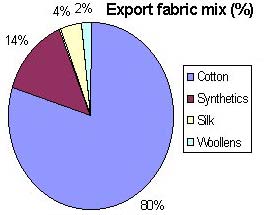| Size of the Industry | Trade growing at a rate of 30% per annum. |
| Geographical distribution | All major cities in India |
| Output per annum | 7% share of industrial production |
| Market Capitalization | Growing at 20% rate |
Indian sub continent is the second largest manufacturer of garments after China being the global leader in garment production. India is known for its high quality garments for men and most of the garment manufacturers are in the Small and Medium scale industry. Indian men's clothing industry has been growing steadily over the past few years, this has been possible owing to the Indian male becoming more fashion conscious, and hence there is more consumption which has increased global demand of men's garments by the rest of the world.
|
India Garment Industry has an advantage as it produces and exports stylish garments for men at economical prices due to cheap labour rates. Today the by the way of Technological advancement and use of sophisticated machinery it has enabled the manufacturers to achieve better quality and well designed garments. India's Garment Industry has been rapidly growing in last few years. Exports have been rising as there is an increase in orders from global buyers accompanied by a rise of investments in the garment sector of the country. The Garment Industry is of major importance to the Indian economy as it contributes substantially to India's export earning, it is estimated and analyzed that one out of every six households in the country depends on this sector either indirectly or directly for its livelihood. From all over the world the Retailers also increasingly come to India attracted by low production costs. The large brands among them are Wal-Mart, Tesco, and M&S. |
 |

India's Garment/ Apparel Market Size
INDIA'S APPAREL MARKET SIZE |
||||||||
2002 |
2003 |
2004 |
2005 |
|||||
Volume ('000 units) |
Value (Rs.Cr,) |
Volume ('000 units) |
Value (Rs.Cr,) |
Volume ('000 units) |
Value (Rs.Cr,) |
Volume ('000 units) |
Value (Rs.Cr,) |
|
Mens Wear |
1254370 |
23335 |
1297220 |
26090 |
1342140 |
29135 |
1393639 |
32590 |
Womens wear |
1236880 |
19130 |
1300610 |
21730 |
1368310 |
24680 |
1443113 |
28375 |
Unisex Apparel |
417810 |
4215 |
434340 |
5240 |
452020 |
5835 |
470978 |
6615 |
Kidswear |
1139870 |
9950 |
1180290 |
10810 |
1222280 |
11745 |
1268933 |
13085 |
Uniforms |
372960 |
4660 |
397210 |
5460 |
423020 |
6345 |
456862 |
7675 |
TOTAL |
4421890 |
61290 |
4609670 |
69330 |
4807770 |
77740 |
5033524 |
88340 |
Today India is booming with fashion and lifestyle, with the organized retail trade growing at a rate of 30% per annum. The Indian apparel or Indian garment industry is pegged at more than 90,000 crores with nearly 13% growth per annum. The men's garment or clothing segment constitutes nearly 45 % of the total apparel market and growing at a constant rate each year. The share of organized branded segment in men's wear is fast increasing in the Indian apparel market.

In 2006, India's textile industry (including garments) contributed 14% to industrial production, 4% to GDP, and 17% to export revenues which directly employed 35 million people including women and backward classes. Apparel exports totaled Rs 50,479 crore in 2009-10 compared to Rs 50,293 crore in 2008-09. But in dollar terms, all months of 2009-10 except July, August and November showed a painful downslide.
- Pantaloon Retail India Ltd
- Shopper's Stop
- Tata - Trent
- Globus stores Pvt Ltd
- Pirmayd Retail Ltd
- Arvind Brands Ltd
- Provogue India Ltd
- The Raymond Group
- Madura Garment
- Reliance Retial Ltd
- Wills lifestyle
- Murjani Group
- Landmark Group
- Gokalda Group
- Zodiac Clothing
- In southern India's Tirupur town, young girls are lured to work in the garment industry with a promise of 'golden opportunity' to earn their own dowry at the end of a three-year apprentice period. Garment industry of Tirupur projects a turnover of Rs 10,000 crore this year, down from Rs 11,000 crore in 2006-07, thanks to the falling dollar. The industry employs 400,000 workers regularly and an additional 500,000 seasonally where most of them women and teenaged girls.
- The Indian Garment industry is today modernized via an exclusive scheme, which has set aside $5bn for investment in improvisation of machinery. International brands like the Levis, JC Penny, Wal-Mart, Gap, Marks & Spencer and other industry giants are sourcing more and more fabrics and garments from India.
- According to a study China and India will be major gainers. Where India could increase their share from present 8 % in US textile market to 13.5% and from 3% to 8% in US Garment market.
- Morgan Stanley has projected India to be one of top three exporters of textile and garments.
- Indian Cotton Mills Federation study has estimated Indian textile exports to reach US $ 40 Billion by 2010 and 12.5% share in the Indian Commodity export basket
- However, the garment industry in India faces stiff competition from countries such as Bangladesh, China and Vietnam. There is a pressure on the Indian garment industries to produce finished garments at lower costs to survive the cut-throat competition. Today, around 45% of the total textile exports in India account for ready-made garments.
- Garment Industry in India is looking at achieving an export target of $25 billion- an Apparel Export Promotion Council (AEPC) official said.
- The industry today would need an additional 1.5 million people
- An investment of Rs. 35000 crore in terms of related infrastructure is required
- AEPC plans to set up 50 training centres besides the 22 centres it has at present across the country.
 Recent Press Release
Recent Press Release
 INDIAN garment INDUSTRY AT A Glance IN 2021 - 2022
INDIAN garment INDUSTRY AT A Glance IN 2021 - 2022
 INDIAN garment INDUSTRY AT A Glance IN 2020 - 2021
INDIAN garment INDUSTRY AT A Glance IN 2020 - 2021
 INDIAN garment INDUSTRY AT A Glance IN 2019 - 2020
INDIAN garment INDUSTRY AT A Glance IN 2019 - 2020
 INDIAN garment INDUSTRY AT A Glance IN 2018 - 2019
INDIAN garment INDUSTRY AT A Glance IN 2018 - 2019
 INDIAN garment INDUSTRY AT A Glance IN 2017 - 2018
INDIAN garment INDUSTRY AT A Glance IN 2017 - 2018
 INDIAN garment INDUSTRY AT A Glance IN 2016 - 2017
INDIAN garment INDUSTRY AT A Glance IN 2016 - 2017
 INDIAN garment INDUSTRY AT A Glance IN 2014 - 2015
INDIAN garment INDUSTRY AT A Glance IN 2014 - 2015
 INDIAN garment INDUSTRY AT A Glance IN 2013 - 2014
INDIAN garment INDUSTRY AT A Glance IN 2013 - 2014
 INDIAN garment INDUSTRY AT A Glance IN 2012 - 2013
INDIAN garment INDUSTRY AT A Glance IN 2012 - 2013
 INDIAN garment INDUSTRY AT A Glance IN 2011 - 2012
INDIAN garment INDUSTRY AT A Glance IN 2011 - 2012
 |
INDIAN INDUSTRIES |




